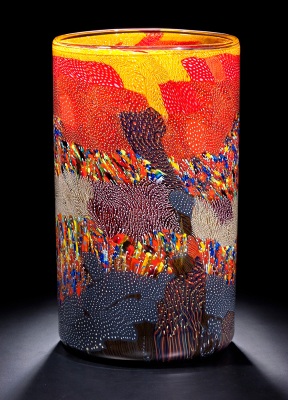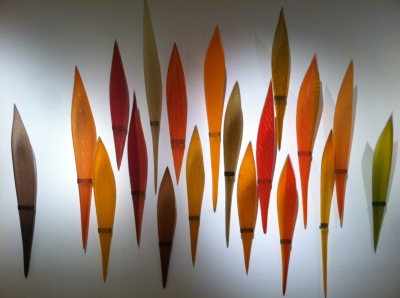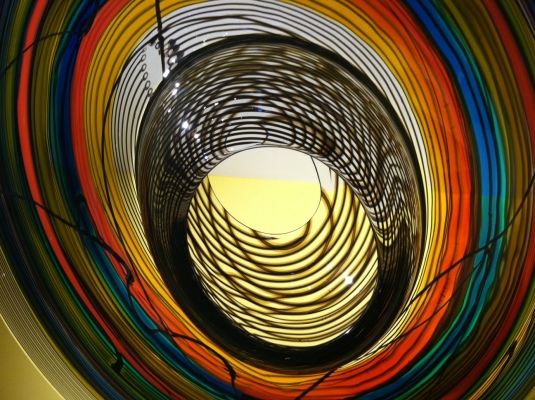 Lino Tagliapietra, Osaka, 2012. Glass. H 21 1/2, W 12 1/4, D 12 3/4 in. courtesy: heller gallery, new york
Lino Tagliapietra, Osaka, 2012. Glass. H 21 1/2, W 12 1/4, D 12 3/4 in. courtesy: heller gallery, new york
Lino Tagliapietra returns to his roots in new work in intense hues that makes up “Colors of Burano,” his solo exhibition at Heller Gallery in New York City on view through May 12th. Not far from Tagliapietra’s native Murano lies the island of Burano, a kaleidoscope of tropical color where houses swathed in brilliant blues, sunset reds, and canary yellow line the tiny roads. In recent years the Italian government has declared the houses a national treasure, and Burano citizens’ choice of hue is now regulated. Visiting relatives on the island as a child, Tagliapietra recalls a time before government control — a time when the colors flowed from spontaneity that is now being preserved. Though he himself was born on the neighboring island of Murano, his family had lived many generations prior on Burano. He would often make the 40-mile boat trip back to his grandmother’s house, and the colors, as he told the GLASS Quarterly Hot Sheet, “have lived in my brain ever since I was a child.”
Tagliapietra spoke animatedly about the complex history of glass in his native Venice, which was alone in producing totally clear glass and remained unchallenged as the best glassmakers in Europe in the 15th and 16th centuries. Secret techniques were closely guarded against the constant threat of competitors’ espionage; for example, the Venetian government tracked two important Muranese glassmakers en route to France and stabbed them to death on the spot, so prized and protected were the techniques of glassmaking on the island. Their advances in the field were such that for a time, only Murano glass makers knew how to produce glass mirrors.
 Tagliapietra stands next to an “Osaka” at his preview at Heller Gallery
Tagliapietra stands next to an “Osaka” at his preview at Heller Gallery
Recognizing how far glass has come from the days of jealously guarding secrets, Tagliapietra himself has made a career of sharing knowledge of process with the understanding it is expression in glass and not strictly technique that matters. Tagliapietra has legions of disciples who have studied or assisted for him, and he’s been hailed from collectors as well as peers such as Dale Chihuly as the most skilled glassblower working today. In a recent Hot Sheet post, Tagliapietra’s personal history was even cited as a source of inspiration for the glass artist Giles Bettison of Canberra, Australia, who links the lacework of the maestro’s mother and his fisherman father as aesthetic influences.
 Masai; Lino Tagliapietra; Heller Gallery
Masai; Lino Tagliapietra; Heller Gallery
The exhibition at Heller includes work from ongoing bodies of work that have been in progress for decades. When questioned about his “Osaka” series, glass vessels almost as wide as they are tall, with a smattering of colors that must be studied from 360-degrees to gain a true appreciation for the variation in design, he eventually concluded he must have begun work on some of the pieces over 30 years ago. The back wall of the gallery is lined with a series known as “Masai,” objects of varying sizes affixed to the wall, giving the impression of a field of surfboards growing like reeds. In fact, Katya Heller informed us these are representative of shields carried by native Kenyan peoples and this particular installation is the largest collection of this series at any one gallery.
 Endeavor; Lino Tagliapietra; Heller Gallery
Endeavor; Lino Tagliapietra; Heller Gallery
In this way, as one enters Heller Gallery confronted by a series of canoe shaped glass hovering overhead, the only aerial installation in the exhibit, there is a real feeling of a master at work, freely revisiting series with a new approach to color and composition. Most pieces in Tagliapietra’s series of epics are grouped together in each annex of the gallery, allowing your eye to easily take in his trajectory in glass making. Upon entering, Endeavor floats seemingly in midair, the illusion completed with the aquamarine wall as a backdrop. The remaining walls of the main gallery are lined with the only kiln-formed glass works in the show, hand painted by Tagliapietra.
Assembled in the center of the room are his “Fuji” series works, grand vessels similar to Osaka, but with a curvy, almost feminine, execution. Throughout this visual retrospective, there is a sprinkling of sculpture that stands alone without counterpart or comparison. Saturno is such an object, mounted on a long metal frame, it has the impression of color whirring around an axis, represented by unfettered negative space at the sculpture’s center.
 Saturno; Lino Tagliapietra; glass/metal stand:77 1/2 X 34 X 15 in
Saturno; Lino Tagliapietra; glass/metal stand:77 1/2 X 34 X 15 in
While artists are quick to draw on Tagliapietra’s work and history as inspiration for their own, and galleries are lucky to represent this much of his work at one time, the artist himself is surprisingly affable. Perusing the gallery with polite interest, he could have been mistaken for an aesthetically minded passer-by as he shook hands and smiled for photos with ease. He neither laughed off, nor seemed dependent upon, his laudatory fan base, but merely accepted compliments with a pleasant and genuine “Thank you.” While admitting he does work in the glass blowing studio every day, either on the design process or its execution, he in no way gives the impression of a man overworked. In fact, most of what comes out of his mouth is the very genuine assertion, “It’s good. It’s very good.”
In this case, he’s right. He’s very right.
-Katharine Morales
IF YOU GO:Lino Tagliapietra: Colors of Burano
Through May 12th, 2012
Heller Gallery
420 W 14th St.
New York, NY 10014
t: 212-414-4014
f: 212-414-2636


